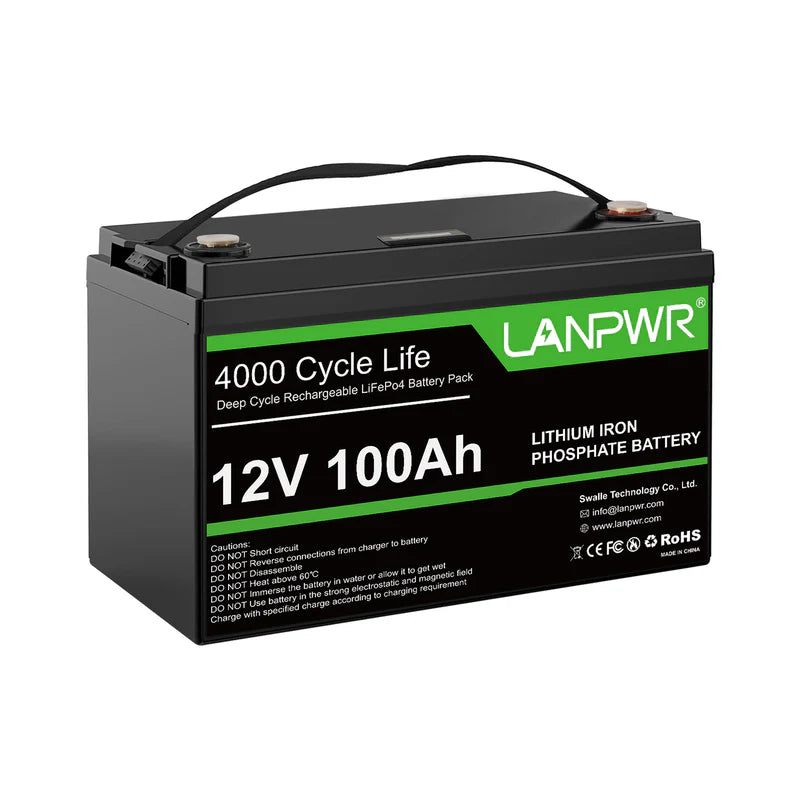Difference between Lithium Iron Batteries, Traditional Batteries
Definition of Lithium Iron Batteries, Traditional Batteries
Lithium batteries use lithium, one of the lightest metals and an excellent conductor of electrical current, as its anode material. Lithium batteries are categorized into two main types: lithium-ion and metal batteries. Rechargeable lithium-ion batteries whereas Traditional batteries typically refer to the older and more commonly used battery technologies that have been a staple in various applications before the widespread adoption of lithium-based batteries.

LANPWR 600W Portable Power Station good example of Lithium Iron batteries.
Differences Between Lithium Batteries and Traditional Batteries
The distinction between lithium and traditional batteries becomes crucial in the evolving landscape of portable energy solutions. Each type offers distinct advantages and disadvantages, influencing their suitability for various applications.
Here are the fundamental differences between these battery types, focusing on their chemical composition, rechargeability, and cost implications.
Understanding Battery Chemistry
Lithium Batteries: They utilize lithium ions as a key component of their electrochemical reaction. These ions move between the anode and cathode during charging and discharging, enabling efficient energy storage and release.
Traditional batteries: Traditional batteries such as alkaline ones use a combination of zinc and manganese dioxide, which results in lower energy output per unit mass.
The Significance of Energy Density
Lithium Batteries: They boast a higher energy density compared to traditional batteries. This means they can store more energy in the same amount of space, making them ideal for high-demand applications like electric vehicles and portable electronics. The higher energy density also translates to longer usage times between charges, enhancing convenience for users.
Rechargeability Features
Lithium Batteries: They are predominantly rechargeable, with the ability to undergo numerous charge-discharge cycles with minimal loss in capacity.
Traditional batteries: They are designed for a single use and then discarded. Rechargeable variants of traditional batteries, such as NiMH and NiCd, do exist but generally do not match the performance metrics of lithium-based counterparts.
Longevity and Economic Efficiency
Lithium Batteries: The extended lifespan of lithium batteries often compensates for their higher initial cost. They are particularly cost-effective in devices requiring frequent recharging, where their long-term reliability and durability can lead to significant savings over time, offsetting the upfront investment.
Rechargeability and Lifespan
- Lithium Batteries: They offer thousands of recharge cycles with minimal degradation, making them ideal for high-usage devices.
- Traditional Batteries: Limited recharge cycles and often shorter overall lifespans, which may not support long-term or intensive use.
Chemistry and Energy Density
- Lithium Batteries: High energy density allows for smaller sizes and lighter weights suitable for modern, portable technology.
- Traditional Batteries: Lower energy density, leading to bulkier and heavier designs that are less efficient for portable use.
Importance of Lithium Batteries Over Traditional Batteries
Lithium batteries have several significant advantages over traditional batteries that make them increasingly popular in both consumer electronics and industrial applications. These advantages are crucial for the modern demands of technology and energy efficiency, and they include:
Higher Efficiency and Longer Lifespan
Lithium batteries are highly efficient in their performance, delivering a larger amount of energy from a smaller size and lighter weight than traditional batteries. This high energy density means that devices can operate longer on a single charge and also contribute to the overall reduction in the weight of the device, enhancing portability and usability. Furthermore, lithium batteries can sustain hundreds to thousands of charge-discharge cycles with minimal degradation over time. This longevity translates to fewer battery replacements, reduced waste, and greater long-term value for consumers.
Fast Charging Capabilities
One of the standout features of lithium batteries is their ability to recharge quickly compared to traditional battery technologies like NiMH or NiCd. This fast-charging capability is essential in today's fast-paced world where time is a valuable commodity. Devices equipped with lithium batteries can be rapidly recharged, minimizing downtime and enhancing productivity, particularly important for tools and devices used in professional settings.
Lower Self-Discharge Rate
Lithium batteries also exhibit a lower self-discharge rate than traditional batteries. A battery's self-discharge rate is the speed at which it loses its charge while not in use. Traditional batteries, such as NiMH, can lose a significant portion of their charge per month when stored, which can be inconvenient and inefficient. In contrast, lithium batteries retain their charge for a much longer period, making them ideal for use in emergency equipment, backup storage solutions, and seasonal applications where they might not be regularly used but must be ready at a moment's notice.
Environmental and Operational Safety Improvements
Although lithium batteries are not without their environmental challenges, they offer improvements over traditional batteries in several ways. For instance, they contain no cadmium or mercury, which are highly toxic metals found in some traditional batteries. This makes them a less hazardous option when considering the environmental impact of battery disposal.
Furthermore, advancements in technology have led to improved safety features within lithium battery systems, such as better thermal management and advanced electronic control systems to prevent issues like overheating and overcharging. While safety concerns still exist, particularly with large-scale battery applications, these ongoing improvements are helping to mitigate risks.
Versatility in Applications
Finally, the versatility of lithium batteries cannot be understated. They are not only fundamental in powering everyday portable devices like smartphones, laptops, and cameras but also crucial in more significant applications such as electric vehicles and renewable energy systems. Their efficiency and capacity for high discharge rates make them ideal for use in electric grids as storage systems that help manage fluctuations in renewable energy production, like solar and wind power.














Leave a comment
This site is protected by hCaptcha and the hCaptcha Privacy Policy and Terms of Service apply.